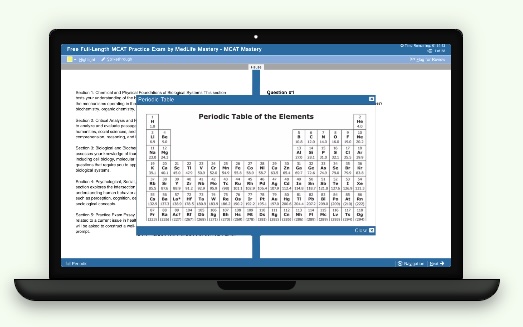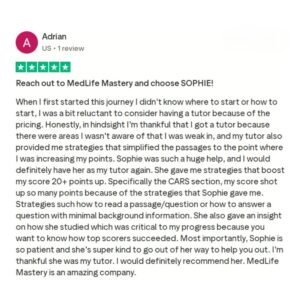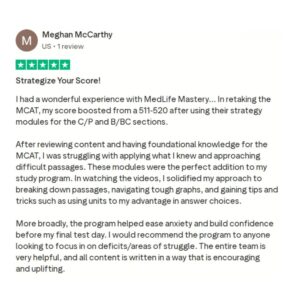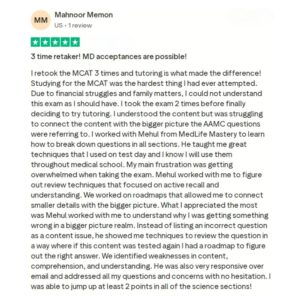Recommended Steps:
- 1Download your free MCAT Mnemonics PDF.
- 2Print or use digital copy to memorize!
- 3Practice your recall below!
MCAT Chemistry/Physics Mnemonics
general chemistry
Oxidation & Reduction
LEO the lion, goes GER
Loss of Electrons ⇒ Oxidation
Gain of Electrons ⇒ Reduction
Types of White Blood Cells
Never Let Monkeys Eat Bananas (from most abundant to least abundant)
Neutrophils
Lymphocytes
Monocytes
Eosinophils
Basophils
DG° = -nFE°
Nernst Equation:
E = E° - (RT/nF)lnQ
Bonding:
H requires 1 more electron in its outer shell to become stable.
O requires 2.
N requires 3.
C requires 4.
Reduction occurs at the Cathode; Oxidation at the Anode.
Remember that the terms beginning with consonants (R & C) are together, and those beginning with vowels (O & A) are together.
Gibb's Free Energy:
DG = DH - TDS
Henderson-Hasselbalch Equation
or "Hong Kong + American Hospital Association"
pH = pKa + log10(A-/HA)
Quantum Numbers:
n, l, m, s
The following are all state functions:
V for volume
G for Gibb's free energy
P for pressure
H for enthalpy
E for internal energy S for entropy
T for temperature
Cation:
The "t" in cation looks like a plus sign: "ca+ion"
Moles deposited at an electrode = It/nF
DG = DG°+ RTlnQ
Anomeric Carbons
Hydrogen Bonding: Hold the F-O-N
Hydrogen + (bonded to) Fluoride, Oxygen, and Nitrogen = Protic solvent.
Other bonding mnemonics:
BARF – Break (a bond), Absorb (energy),Release(energy), Form (a bond)
SNAP - Symmetrical (molecule) Nonpolar Asymmetrical (molecule) Polar
TICS -Transfer Ionic, Covalent Share
Strength of bonds and intermolecular forces from strong to weak:
I Can’t Handle Dirty Vans - (Ionic, Covalent, Hydrogen, Dipole, Van der Waals
S, P, D, F
Then it follows the alphabet: g, h, i, j, k, etc.
Tera, Giga, Mega, Kilo, Deca - Deci, centi,
milli, micro, nano, pico
Chemistry
Sequence of orbitals
s
p
d
f
g
h
i
k
Periodic table – Periods 1-3 Hydrogen
Helium
Lithium
Beryllium
Boron
Carbon
Nitrogen
Oxygen
Fluorine
Neon
Na (Sodium)
Magnesium
Aluminum
Silicon
Phosphorous
Sulfur
Chlorine
Argon
Periodic table – Period 4
K (Potassium)
Calcium
Scandium
Titanium
Vanadium
Chromium
Manganese
Fe (Iron)
Cobalt
Nickel
Cu (Copper)
Zinc
Gallium
Germanium
Arsenic
Selenium
Bromine
Krypton
Periodic table – Period 5
Rubidium
Strontium
Yttrium
Zirconium
Niobium
Molybdenum
Technetium
Ruthenium
Rhodium
Palladium
Silver (Ag)
Cadmium
Indium
Tin (Sn)
Antimony (Sb)
Tellurium
Iodine
Xenon
Noble gases
Helium
Neon
Argon
Krypton
Xenon
Radon
First transition metals
Scandium
Titanium
Vanadium
Chromium
Manganese
Iron (Fe)
Cobalt
Nickel
Copper (Cu)
Zinc
Second transition metals
Yttrium
Zirconium
Niobium
Molybdenum
Technetium
Ruthenium
Rhodium
Palladium
Silver (Ag)
Cadmium
Third transition metals
Lanthanum
Hafnium
Tantalum
Tungsten (W)
Rhenium
Osmium
Iridium
Platinum
Gold (Au)
Mercury (Hg)
Actinides
Actinium
Thorium
Protactinium
Uranium
Neptunium
Plutonium
Americium
Curium
Berkelium
Californium
Einsteinium
Fermium
Mendelevium
Nobelium
Lawrencium
(electrons) Flow from Anode To CAThode
Lanthanides
Lanthanum
Cerium
Praseodymium
Neodymium
Promethium
Samarium
Europium
Gadolinium
Terbium
Dysprosium
Holmium
Erbium
Thulium
Ytterbium
Lutetium
Alkali metals
Lithium
Sodium (Na)
Potassium (K)
Rubidium
Cesium
Francium
Alkaline earth metals
Beryllium
Magnesium
Calcium
Strontium
Barium
Radium
Chalcogens
Oxygen
Sulfur
Selenium
Tellurium
Polonium
Livermorium
Halogens
Fluorine
Chlorine
Bromine
Iodine
Astatine
Tennessine
Properties of elements according to:
Abundance of elements on the crust of the earth
Oxygen(O) > Silicon(Si) > Aluminum(Al) > Iron(Fe) > Calcium(Ca) > Sodium (Na) > Potassium(K) > Magnesium (Mg)
*The remainder just contributes 1%.
Activity series of metals
Potassium > Sodium > Calcium > Magnesium > Aluminum> (Carbon)* > Zinc > Chromium > Iron> Tin > Lead > (Hydrogen)* > Copper > Mercury > Silver > Gold > Platinum
*Note: Hydrogen and Carbon are non-metals used as a baseline.
Diatomic molecules
Hydrogen
Nitrogen
Oxygen
Fluorine
Chlorine
Bromine
Iodine
Anode has Oxidation Reduction at the Cathode
Prefixes for naming carbon chains
1 Meth
2 Eth
3 Prop
4 But
Aromatic substituent prefixes
Ortho
Meta
Para
Carboxylic acids
Formic
Acetic
Propionic
Butyric
Valeric
Caproic
Bronsted-Lowery Acid donates (Base accepts)
H2, N2, F2, 02, I2, CI2, Br2
Alpha = trans/down
Beta = cis/up
physics
Formula for work
Work = Mass * Acceleration * Distance
Ideal Gas law
PV = nRT
Gibbs's free energy formula
Δ G = Δ H – T Δ S
Ohm’s law
Volts = Amps x Resistance
Relation between resistivity and resistance
Resistance = ρ (Length/Area)
Order of rainbow colors
Red
Orange
Yellow
Green
Blue
Indigo
Violet
Represented by the number of letters in each word in the sentence:
“We guarantee certainty, clearly referring to this light mnemonic.”
Speed of light
299,792,458 meters per second
Capacitive and inductive circuits
The EMF (E) for an inductive (L) circuit is greater than the current (I)
While the current (I) for a capacitive circuit (C) is greater than the EMF (E).
Electromagnetic Spectrum (in order of increasing frequency and decreasing wavelength)
Ronald Mcdonald Invented Very Unusual & eXcellent Gherkins
OR
Ronald Mcdonald Is Visiting Ur X-Girlfriend (with increasing frequency)
Radio
Micro
Infrared
Visible spectrum
Ultra-violet
X-rays
Gamma
VISIBLE LIGHT (in order of increasing frequency): ROYGBIV
Violet is violent therefore it contains a lot of energy and has the longest frequency.
Order of increasing wavelength
Gamma Rays
X-Rays
Ultraviolet
Visible light
Infrared
Microwaves
Radio waves
Prefixes of the metric system
Kilo
Hector
Deca
Base
Deci
Centi
Milli
Micro
Steps in the scientific method
Problem
Research
Hypothesis
Experiment/data
Analyze
Conclusion
Communicate
Levels of the atmosphere
Troposphere
Stratosphere
Mesosphere
Thermosphere
Exosphere
Resistor color code
Black (0)
Brown (1)
Red (2)
Orange (3)
Yellow (4)
Green (5)
Blue (6)
Violet/purple (7)
Gray (8)
White (9)
Relationship between object and image distance, and focal length, from a lens or mirror
1/f = 1/do + 1/di
Focal length
Distance of object
Image distance
Left Add Right Subtract
(When moving the decimal to the left, add to your exponent, and vice versa)
Upright images are always Virtual Inverted images are always Real
(for a single lens or single mirror)
Diverging always Upright & Virtual
V(final) = V(initial) + (AT)
V = velocity
A = acceleration
T = time
V(final)^2 = V(initial)^2 + 2AX
V = velocity
A = acceleration
X = distance
X = V(initial)T + ½ AT^2
V = velocity
A = acceleration
X = distance
T = time
Force on a Charge Moving in a Magnetic Field:
if direction is perp. To magnetic field
Fast Quality Vitalizes Business
F=QvB
Newtons= C x m/s x T
Ideal Gas Law
PV = nRT
Gibbs’s Free Energy Formula
△ G = △ H - T △ S
Ohm’s Law
Volts = Amps x Resistance
Relation Between Resistivity and Resistance
Resistance = p (Length / Area)
Em Spectrum
Radio, Microwaves, Infrared, Visible light, UV, X-ray, Gamma
Spectral Lines
Lyman, Balmer, Paschen
Levels of The Atmosphere
Troposphere, Stratosphere, Mesosphere, Thermosphere, Exosphere
Formula for Work
Work = (Mass) * (Acceleration) * (Distance)
Sine = Opposite / Hypotenuse
Cosine = Adjacent / Hypotenuse
Tangent = Opposite / Adjacent
Cation Charge
Cations hold + charges
H, He, Li, Be, B, C, N, O, F, Ne
Hydrogen, Helium, Lithium, Beryllium, Boron, Carbon, Nitrogen, Oxygen, Flourine, Neon
Arrenhius = acid forms H*3*0+ & base forms OH- in water (most elementary definition).
Brownsted-Lowry = acids donate protons (H+) and bases accept them.
Lewis = acids accept electron pairs and bases donate them.
Le Chatelier’s Principle and Equilibrium
K> Q then reaction will go right, increasing
product concentration.
K< Q then reaction will go left, increasing reactant concentration.
Sequence of Orbitals
s → p → d → f → g → h → i → k
Noble Gases
Helium, Neon, Argon, Krypton, Xenon, Radon
Alkali Metals
Li, Na, K, Rb, Cs, Fr
Halogens
Fluourine, Chlorine, Bromine, Iodine, Astatine, Tennessine
Bonding Hydrogen
Hydrogen needs 1 (electron in it's outer shell to become stable)
Oxygen needs 2
Nitrogen needs 3
Carbon needs 4
Heat Transfer Equation
q = mc△T
Resonance, Induction, Size, Electronegativity
Capacitors-Charge
Quintessential Curriculum Vitae
Q=CV
or
Q = VC (like….QVC, the shopping channel)
OR
Quite Curvy and Voluptuous
Capacitors-Energy
E= 1/2QV
Vision (Myopia & Hyperopia)
Myopia ⇒ NEARsighted vision.
- a person with myopia would say: Come near me, so I can see you.
-come NEAR MY OPIum!
Hyperopia ⇒ FARsighted vision
- since hyper means above or beyond you know they can only see above and beyond normal distance.
Force on a Charge Moving in a Magnetic Field:
If direction is perpendicular to the magnetic field
F=QvB
Newtons= C x m/s x T
Optics
ConcaveD = think “D- for diverging”. Can’t add D to Convex. ConvexD isn’t a word!”
Convex= think that the bottom of the lens makes a “V” as in conVex.
Diverging mirrors and lenses - the image is always
Diminished
Upright
Virtual
organic chemistry
Basic Amino Acids:
Histidine
Arginine
Lysine
(Thanks to ExamKrackers)
Secondary amine ? Enamine
Primary amine ? Imine
(Note: tertiary and quaternary amines do not react with the C=0 group.)
Cis/trans (Geometric) Isomers
Thus, even though they may have stereogenic centers, they are achiral and so do not have enantiomers.
Substitution Electrophilic - Aromatic
Most Other Reactions - Nucleophilic Substitution
Carbonyl - Addition Nucleophilic
Pi bonds - Electrophilic Addition
Anything that it takes to do something or go somewhere.
Bladder (gotta GO pee), musculoskeletal system, cardiovascular system (running and moving), tendons etc (to pull against), etc
Nonpolar (hydrophobic) Amino Acids:
I saw (ISO) LEUcy METHodically PRObe and PHEel ALAN and then VAL TRYPped on the GLYCINE
(Isoleucine, Leucine, Methionine, Proline, Phenylalanine, Alanine, Valine, Tryptophan, Glycine)
Z for same side and E for opposite sides
Q Quaternary amino -NR3+
E Ester -COOR
S Sulfonic acid -SO3H
N Nitro -NO2
C Carbonyl -CHO
C Carboxyl -COOH
C Cyano -CN
Ortho- and Para- Directing Groups on a Benezene Ring
Elastic modulus = stress / strain i.e. "es" / "ai" or "essay"
INsuline = glucose go INto the cell.
GlucaGON = glucose GONE from the cell.
CalciTONin TONES down calcium concentrations in the blood.
Gauche conformation:
It's "gauche" (inappropriate) for one methyl group to stand too close to another group.
Cyclohexane ring: When you have low energy, you sit down in a "CHAIR" to rest.
"BOATS" can be tippy, so they are less stable.
A Alkyl -R
H Halogen -X A Alkoxyl -OR
A Amino -NH2, -NHR, -NR2 (not -NR3+) H Hydroxyl -OH
A Amide -NHCOR
P Phenyl -C6H5
Galvanic cells ARE electrolytic cells (synonyms) and the anode is negative in the other cell type (non electrolytic)
Cathode and Reduce both have "C" in them (So anodes ALWAYS oxidize).
Oil Rig (oxidation is loss [of electrons], Reduction is Gain)
Another way to remember this same thing is to look at the CHARGE above the atom.
Ag (in ground state, the CHARGE is 0) --> Ag+ (this has been OXIDIZED) since the number above Ag has increased.
Cu3+ --> Cu2+ (this has been REDUCED since the number above it is REDUCED [went down]
Cl --> Cl- (this is also REDUCED [went from 0 --> -1]
If you remember this, you don't need to remember OIL RIG or LEO says GER
E lectrolytic (galvanic)
P ositive
A node
Methane, Ethane, Propane, Butane, Pentane,
Hexane, Heptane, Octane, Nonane
MCAT Biology/Biochemistry Mnemonics
bIOLOGY
Hormones Produced & Secreted by the Anterior Pituitary
FLAT PEG
Follicle Stimulating Hormone (FSH)
Luteinizing Hormone (LH)
Adrenocorticotropin Hormone (ACTH)
Thyroid Stimulating Hormone (TSH)
Prolactin
Endorphins
Growth Hormone
*Note: FLAT refers to tropic hormones while PEG refers to direct acting hormones.
OR
“FLAT
PiG lived in the ANT PIT (anterior pituitary)”
FSH
LH
ACTH
TSH
Prolactin
i
GH
OR
FLAT PEGgy is a Direct woman who lived in the ANT PIT.
PEG = direct hormones; the others all are tropic hormones.
OR
FLAT trop (ical) beach and pegs go directly into a board ( FLAT = tropic hormones)
Oxidation & Reduction
OIL RIG
Oxidation is Loss
Reduction is Gain
**Reducing is reducing the oxidation number, making it more negative
Blotting Techniques
S - Southern blot D - DNA (via DNA probe)
N - Northern blot R - RNA (via DNA probe)
O - omit O - omit
W - Western blot P - protein (via antibody probe)
D - DNA (via DNA probe)
R - RNA (via DNA probe)
O - omit
P - protein (via antibody probe)
Spinal Cord Nerve Origins
Sensory Neurons are afferent & on the dorsal side, while Motor Neurons are efferent & on the ventral side.
SAME DAVE:
Sensory
Afferent
Motor
Efferent
Dorsal
Afferent
Ventral
Efferent
Mesoderm
Things that help us move. Includes, bones, muscles, circulatory system, kidneys (hydrate), gonads
Endoderm
Endernal sounds like “internal”, like “internal organs”. Includes GI tract, respiratory system, accessory organs
Deviations from Hardy-Weinberg Equilibrium are caused by:
Maggie Mae Does Not Smoke
Mutations
Migration
Drift (genetic drift)
Non-random mating
Selection
The Cell Cycle
Growth Phase 1
DNA Synthesis
Growth Phase 2
Mitosis
Cytokinesi
Mitosis = PMAT
Prophase
Metaphase
Anaphase
Telophase
PRImary oocyte arrests in PROphase I
And SECondary oocyte arrest in METaphase II
So, PRI PRO SEC MET
think of it like a chant
Chordate Features
CHORey!- Do Not Pinch People
Dorsal, hollow nerve cord
Notochord
Pharyngeal slits
Postanal tail
Stages in Embryonic Development
Must Be Good
Morula
Blastula
Gastrula
OR
Developing Embryos (babies) Must Be Good
Fat-Soluble Vitamins
Vitamins A
D
E
K
Enzymes/Hormones of the Small Intestine
SLAM DECS
Sucrase
Lactase
Aminopeptidase
Maltase
Dipeptidase
Enterokinase
Cholecystokinin (CCK)
Secretin
OR
Garlic Cloves Smell Exquisite
Gastrin
Cholecystokinin (CCK)
Secretin
Enterogastrone (aka gastric inhib peptide)
OR
“i
C Damsels in distress” (because their hormones make them poop!).
Cholecystokinin (CCK)
Dipeptidase
Aminopeptidase
Maltase
Sucrase
Enterokinase
Lactase
Secretin
Hormones that Increase Blood Glucose
Somatotropin
Thyroid Hormones (thyroxine and triiodothyronine)
Epinephrine
Norepinephrine
Glucagon
Glucocorticosteroids
Immunoglobulins
IgM
IgA
IgD
IgG
IgE
Kingdoms
Monera
Protista
Fungi
Plants
Animals
Male Reproductive Track
Seminiferous Tubules
Epididymis
Vas Deferens
(Nothing)
Urethra
Penis
Menstrual Cycle
Follicular Phase
Ovulatory Phase
Luteal Phase
Pyrimidines
Cytosine
Uracil and
Thiamine are
PYramidines
Purines
Guanine and
Adenine are
Purines
Relationship Between Purines and Pyrimidines
Adenine bonds to
Thymine;
Cytosine bonds to
Guanine
Proteases in the Duodenum
Enterokinase
Trypsin
Chymotrypsin
Carboxypeptidase
Elastase
Striated Muscle
Z-line
I-band
A-band
H-zone
Morula -> Blastula -> Gastrula -> Neuralation
Gamete → Zygote → Embryo → Fetus
Ectoderm
Things that we might find attractive... or not. Includes skin, eyes, glands (sweat, mammary, etc), nervous system
Salt on the outside of a Bananna
Na is high outside (a cell), K (potassium) is high inside (the cell / bananna)
Beta
Alpha
Delta of
Pancreas release insulin
Glucagon
Somatostatin
CAlcium - Dependent adHERINg of cells
Function of Estrogen / Progesterone in the endometrium
Your body produces Glucagon when your GLUcose levels are Gone
Calcitonin TONEs down CALcium levels (vs. PTH, which raises blood calcium)
Osteoblasts Build Bone (vs. osteoclasts, which do the opposite / clash)
If trp is low, trp repressor gets kicked off (“tripped off”), RNA polymerase then makes more trp
LAC operon isn’t being expressed when LAC is low
Introns are the transcribed part of the nucleotide sequence in an mRNA and bound to carry the non-coding part for the proteins. Exons are the transcribed part of the nucleotide sequence in mRNA that's liable for protein synthesis.
Kingdom
Phylum
Class
Order
Family
Genus
Species
Neutrophils
Lymphocytes
Monocytes
Eosinophils
Basophils
DNA is read 3'-5' left to right like we read.
But is synthesized 5'-3' largest to smallest just how a pyramid is built.
White Blood Cells
(In order of decreasing numbers)
Neutrophils
Lymphocytes
Monocytes
Eosinophils
Basophils
Calcitonin decreases blood Ca2+ levels (PTH is the opposite)
Dyneins go toward the center of the cell (Dine in)
Kinesins go toward the exterior of cell (Carry out)
biochemistry
Non-polar amino acids
Glycine (G)
Alanine (Ala)
Leucine (Leu)
Isoleucine (Ile)
Methionine (Met)
Valine (Val)
Proline (Pro)
Tryptophan (Trp)
Phenylalanine (Phe)
Polar uncharged amino acids
Glutamine (Gln)
Serine (Ser)
Threonine (Thr)
Cysteine (Cys)
Asparagine (Asn)
Electric amino acids
Glutamic acid (Glu, E)
Aspartic acid (Asp, D)
Lysine (Lys, K)
Arginine (Arg, R)
Histidine (His, H)
Positive amino acids
Histidine
Lysine
Arginine
Aromatic amino acids
Tyrosine
Tryptophan
Phenylalanine
Hydrophobic alkyl side chains
Valine
Phenylalanine (the one-letter abbreviation is F, not P)
Alanine
Isoleucine
Leucine
Molecules in the TCA cycle
Citrate
I
Ketoglutarate
Succinyl
Succinate
Fumarate
Malate
Oxaloacetate
3 NADH, 1 FADH, 3 CO, 1 GTP
Co2, Acid, 2,3-DPG, Exercise, Temp (all shift curve to the right)
Aromatic AAs:
Phenylalanine
Tyrosine
Tryptophan
Start Codon:
A
U
G
(Met)
Vitamins K, E, D, A are all fat soluble
Enzymes in the TCA cycle
Citrate synthase
Cis-aconitase
Isocitrate dehydrogenase
A-α-ketoglutarate dehydrogenase Succinyl CoA synthetase
Succinate dehydrogenase
Fumarase
Malate dehydrogenase
TCA cycle products
Net of 3
NADH, 1 GTP, 1 FADH2
GTP produced in between Succinyl-CoA & Succinate
FADH2 produced in between Succinate & Fumarate
Molecules in glycolysis
Glucose
Glucose-6-phosphate
Fructose-6-phosphate
Fructose-1,6-bisphosphate
DHAP
Glyceraldehyde-3-phosphate
B-1, 3-bisphosphoglycerate
P-3-phosphoglycerate
P-2-phosphoglycerate, PEP
Pyruvate
Enzymes in irreversible steps
Hexokinase
Glucokinase
PFK-1
Pyruvate
Kinase
Hydrophilic AAs
Glutamate
Aspartate
Glutamine (the one-letter abbreviation is Q, not G)
Asparagine (the one-letter abbreviation is N, not A)
Lysine (abbreviation is K)
Arginine (R)
Histidine
Three stop codons
UAA
UGA
UAG
Southern blot = DNA
Northern blot = RNA
O O
Western blot = Proteins
Purines: Adenine and Guanine
Glucose → G6P → F6P → F1-6BiP → G3P+DHP → G3P (DAHP converted to G3P) → 1,3-Bpg → 3-P → 2-P → PEP → Pyruvate
Hexokinase -> Phosphogluco Isomerase -> Phosphofructokinase -> Aldolase -> Triosephophate Isomerase -> Glyceraldehyde-3-Phosphate (G3P) Dehydrogenase -> Phosphoglycerate Kinase -> Phosphoglycerate mutase -> Enolase -> Pyruvate Kinase
Citrate -> Isocitrate -> A-ketogluterate -> Succinyl-CoA -> Succinate -> Fumarate -> Malate -> Oxaloacetate
Citrate Synthase -> Aconitase -> Isocitrate Dehydrogenase -> Alpha-ketoglutarate Dehydrogenase -> Succinyl-CoA Synthetase -> Succinate Dehydrogenase -> Fumarase -> Malate Dehydrogenase
Enzymes in Irreversible Steps:
Hexokinase
Glucokinase
PFK-1
(Pyruvate)
Kinase
3 Na out, 2K in, 1 ATP
Non-polar AAs:
G
A
V
L
I
M
F
W
P
Polar AAs:
S
T
C
N
Q
Y
Acidic AAs:
D
E
Basic AAs (Karen’s are basic):
K
R
H
Polar Uncharged AA’s:
Glutamine
Serine
Asparagine
Cysteine
Threonine
Electric AA‘s:
H
R
D
K
E
MCAT Psychology/Sociology Mnemonics
psychology
Freud’s Stages of Psychosexual Development
Owls Always Play Late Games
OR
Oral Butt (Anal) PLuG
Oral stage
Anal stage
Phallic stage
Latency stage
Genital stage
Freud Ages
(odd numbers only!)
1-3-5-Puberty-Adult
Piaget’s stages of cognitive development
Sensorimotor
Preoperational
Concrete Operations
Formal Operations
Erik Erikson’s Stages of Development
Trust vs. Mistrust
Autonomy vs. Shame and Doubt
Initiative vs. Guilt
Industry vs. Inferiority
Identity vs. Confusion
Intimacy vs. Isolation
Generativity vs. Stagnation
Integrity vs. Despair
Kubler-Ross stages of grief
Denial
Anger
Bargaining
Depression
Acceptance
Types of reinforcement
Positive
Negative
Primary
Conditional
Theories of personality
Psychoanalytic
Humanistic
Trait
Social/Cognitive
Behaviorism
Three components of parallel processing
Color
Motion
Shapes
Three components of attitude
- A-Affective (component)- Think affectionate = I LOVE oatmeal; emotional
- B- Behavioral (component) - Think behaves or acts
- C- Cognitive (component) - Think cognition or thinking
“All Prejudice Boys Do Crazy Shit”
Affective = Prejudice
Behavioral = Discrimination
Cognitive = Stereotype
OR
A & P (Anatomy and Physio) aka Affective & Prejudice = overall attitude and emotional response
B & D- Bachelor's Degree aka discrimination & behavioral
C & S- Cognitive Science/Computer Science aka cognitive and stereotype
*It can also be C A N O E, depending on your preference.
Five elements of personality
Openness
Conscientiousness
Extraversion
Agreeableness
Neuroticism
Three most important features of attraction
Similarity
Reciprocity
Proximity
Most common mental and psychiatric disorders
Depression
Anxiety
Bipolar Disorder
Phobia
Autism
Schizophrenia
Symptoms of major depressive disorder
Loss of:
Concentration
Appetite
Interest
Guilt
Energy
Will to leave
Sleep
Components of self-determination theory
Competence
Autonomy
Relatedness
Four primary factors for motivation
Drives
Arousal
Needs
Instincts
Components of general adaptation syndrome
Alarm
Resistance
Exhaustion
Four cores of ethical tenets
Beneficence
Justice
Nonmaleficence
Autonomy
Sequential order of brain waves
Beta
Alpha
Theta
Delta
Seven regions of the brain
Anterior Cingulate Cortex
Broca's Area
Caudate Nucleus
Cerebellum
Frontal Pole
Prefrontal Cortex
Primary Visual Cortex
Functions of meninges
Reabsorb CSF
Anchor brain
Protect brain
Layers of meninges
Pia mater
Arachnoid space
Dura mater
Four primary stimuli
Chemical
Pressure
Light
Temperature
EEG Stages of Sleep: BATs in KaveSS
DD-REaM.
B = Beta - awake
A = Alpha- awake but tired
Stage 1 = Theta - asleep
Stage 2 = K-complexes and Sleep Spindles
Stage 3 = Delta
Stage 4 = Delta
REM = dreams
BATS Drink Blood - beta (awake) alpha (drowsy) theta (stage 1) sleep spindles/k complexes (stage 2) delta (stage 3/4) beta (back awake). Of course you could replace the blood b with REM cause it contains beta, alpha, and other random waves.
Universal emotions
Anger
Surprise
Disgust
Enjoyment
Fear
Sadness
Types of stressors
Nutritional
Environmental
Emotional
Dental
Physiological markers of emotions
Changes in:
Pulse
Adrenaline
Temperature
Respiration rate
Blood pressure
James Lange theory has action happen first, then emotional response. Just like James Bond.
Cannon-Bard, think of two pirate ships firing their cannons simultaneously
Schacter-Singer
Event -> Physiological Response -> Labeling ->
Emotion
Scare -> Singer screams -> realizes it's a surprise party -> experiences emotion
Cornea
Iris
Pupils
Lens
Retina
Hyperopia = Farsighted = fixed with Converging lens = focus image Behind retina
Myopia = Nearsighted = fixed with Converging lens = focus image in Front of retina
Sensorimotor → Pre-operations → Concrete Operational → Formal Operational
Oral (0-1) -> Anal (1-3)-> Phallic (3-6) -> Latent
(6-puberty) -> Genital (puberty+)
Physiological, Safety → Belonging / Love → Self-esteem → Self-actualization
Anger, Surprise, Disgust, Fear, Gloomy (sad), Happy
“Proactive interference: Old memories interfere with new ones Retroactive interference: New memories interfere with old ones”
Sulcus are the grooves / wrinkles on the brain
Pons controls sleep
SUPerior colliculus is for visual sensorimotor reflexes
Distractible, Insomnia, Grandiosity, Flight of Ideas, Agitation, (pressured) Speech, Thoughtless and risky behavior
1. Weird (paranoid, schizotypical, schizoid)
2. Wild (antisocial, borderline, histrionic, narcissistic)
3. Worried (avoidant, dependent, obsessive compulsive
Positive
Negative
Primary
Conditional
Psychoanalytic
Humanistic
Trait
Behaviorism
Social / Cognitive
Depression
Anxiety
Bipolar Disorder
Phobia
Autism
Schizophrenia
Instincts
Needs
Drives
Arousal
Exhaustion
Alarm
Resistance
Changes in:
Blood Pressure
Temperature
Respiration rate
Adrenaline
Pulse
sociology
Different types of identities
Race/Ethnicity
Gender
Politics
Religion
Age
Sexual Orientation
Class
Social facilitation theoretical approaches
Activation Theory
Evaluation Approach
Social Interaction Theory
Attention Approach
Self-Presentation Approach
Types of social norms
Descriptive
Injunctive
Prescriptive
Proscriptive
Subjective
Agents of socialization
Family
Peers
School
Workplace
Religion
Government
Mass Media
Elements of culture
Values
Artifacts
Economy
Norms
Symbols
Society
Language
Factors of globalization
Economy
Industrial Organization
Historical
Technology
Financial
Politics
Characteristics of an ideal bureaucracy
Well-trained Employees
Impartiality
Division of Labor
Formalized Rules
Hierarchy of Organization
Types of non-verbal communication
Body Language
Gestures
Posture
Facial Expressions
Eye Contact
Proscriptive
Subjective
Prescriptive
Injunctive
Descriptive
Artifacts
Values
Language
Economy
Norms
Symbols
Society
Economy
Industrial Organization
Historical
Technology
Financial
Politics
Well-trained Employees
Impartiality
Division of Labor
Formalized
Rules
Hierarchy of Organization
Body Language
Gestures
Posture
Facial Expressions
Eye Contact

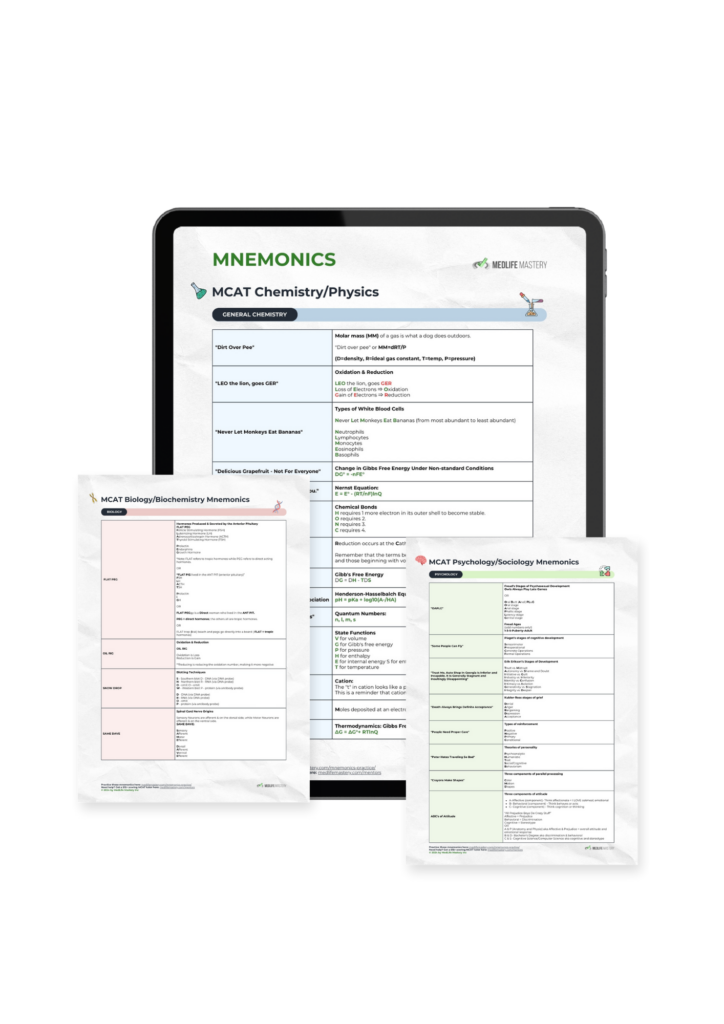

 To help you achieve your goal MCAT score, we take turns hosting these
To help you achieve your goal MCAT score, we take turns hosting these 